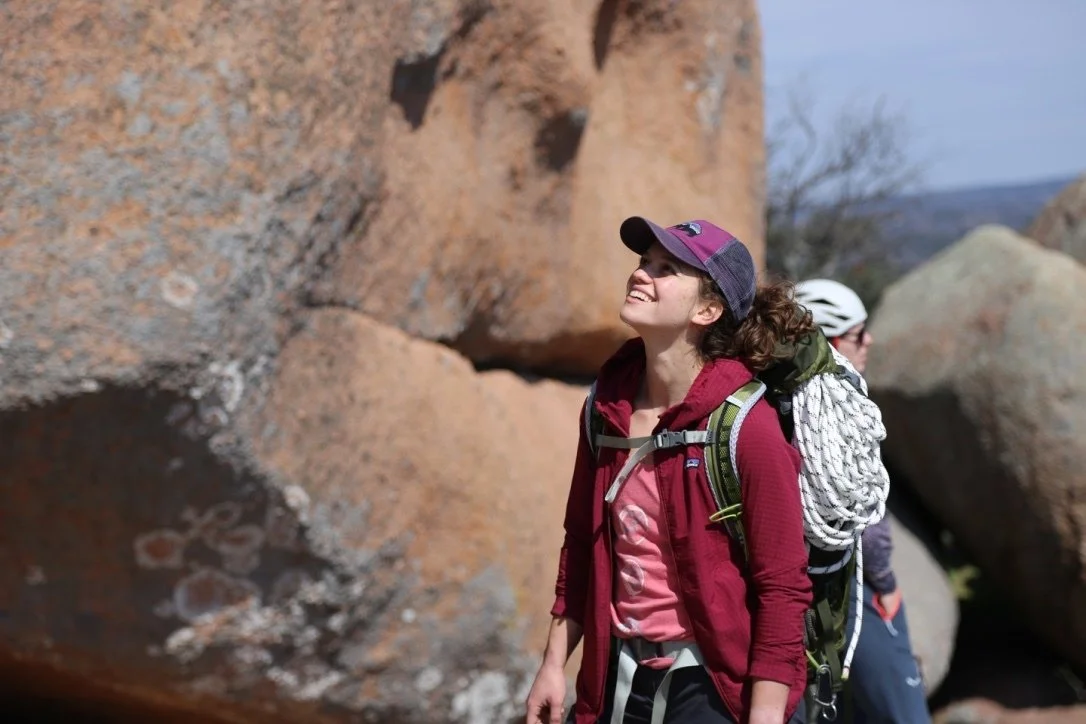Alyssa’s call to climbing advocacy came in 2015 when Medicine Wall—San Antonio’s one and only local crag—was closed indefinitely by the landowner. Shortly after that closure, Alyssa joined the board of the Texas Climbers Coalition (TCC) where she led and elevated the organization’s reach and fundraising efforts in the community. Around the same time, TCC and Access Fund acquired and permanently protected both Medicine Wall and a similar crag outside of Austin called Monster Rock. Alyssa rose quickly to executive director where she expanded the geographic representation of the board, planned and executed major stewardship projects, grew TCC’s annual fundraising event, and launched a rebolting crew.
Six Questions for Alyssa Garza:
Alyssa on the sharp end at Inks Ranch, Texas. © Brian Tickle.
What makes climbing in Texas so special?
Compared to many other areas, crags in Texas are very well cared for. Since we generally aren’t as blessed with large, public lands as some other states, we really take care of what we have. Fixed anchors are remarkably well-maintained, trash is scant, and trails are not overly eroded. Texas might also be unique in that there is such vast potential for new climbing on private land.
What does it mean to you to be a climbing advocate?
For me, it comes down to a desire to help conserve and protect natural spaces in the highest capacity possible. That might mean small acts like picking up trash, or it could mean large acts like donating your hard-earned money to an organization like TCC. It all comes down to seeing climbing beyond your own basic self interests, and wanting to see climbing opportunities grow in the healthiest way possible.
What advice would you give to a new climbing advocate?
Don’t assume that your current challenge—whatever it might be—is a permanent situation. I started climbing at a time when my main outdoor crag closed, and I assumed that it would be closed forever. My assumption was proven wrong in just a few short years after TCC and Access Fund acquired and reopened the crag.
And above all, separate yourself from the individualistic endeavor. Think about the larger interests of the climbing community. Remember that grassroots advocacy and persistence goes a long way!
What surprised you the most about getting into the advocacy world?
I was certainly surprised by how much responsibility comes with owning land. No one tells you that climbing advocacy might come down to protesting your property taxes! It has also been very challenging to navigate a few rogue bolting incidents that we’ve confronted in Austin over the last couple of years. It’s disheartening to see the passion of climbers go in the absolute wrong direction. But these challenges also revealed that there are so many climbers who are willing to help, donate their time, and pour untold amounts of sweat equity into our crags.
What’s your favorite cause in climbing advocacy right now
I’m most inspired by projects that involve introducing people, especially young people, to the outdoors. As a kid, I didn’t spend a lot of time outside. It wasn’t until adulthood that I really came to understand the value of being outdoors. So, I’m always interested in projects that reduce the barrier of entry in connecting kids—particularly disadvantaged kids—to the outdoors.
Increasingly, I’m also interested in advocacy that brings inclusivity into how new climbing areas are developed. Specifically, expanding route development opportunities for women. I was introduced to this process a few years ago and it has been one of the more enduring facets of climbing advocacy for me.
Who is another climbing advocate whose work is really inspiring you right now?
Patrick Dyson. Patrick has acted as a mentor for me in the hard skills of route development and fixed anchor maintenance, as well as in the finer points of interpersonal relationships with the climbing community.


